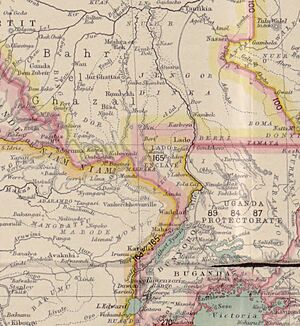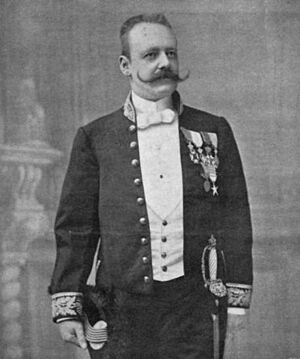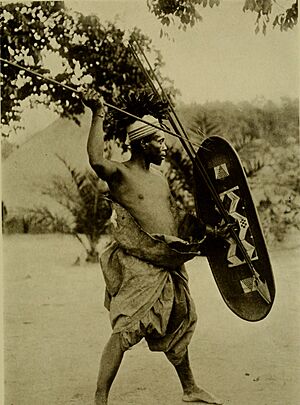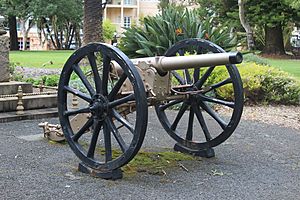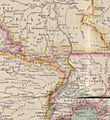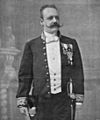Battle of Rejaf facts for kids
Quick facts for kids Battle of Rejaf |
|||||||
|---|---|---|---|---|---|---|---|
| Part of the Mahdist War | |||||||
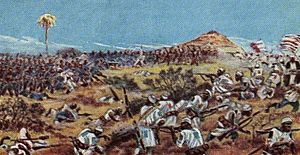 Troops of the Congo Free State engage with the Mahdists at Rejaf along the Nile. |
|||||||
|
|||||||
| Belligerents | |||||||
| Commanders and leaders | |||||||
| Strength | |||||||
| 800 Congolese regulars 500 Azande lancers |
2,000 Mahdist rebels | ||||||
| Casualties and losses | |||||||
| Relatively light | Several hundred killed | ||||||
The Battle of Rejaf, also known as the Battle of Bedden, was a fight that happened on February 17, 1897. It was between forces from the Congo Free State, led by Belgian officers, and a group called the Mahdists in what is now South Sudan. The Congo Free State won this battle.
This victory pushed the Mahdists out of an area called the Lado Enclave for good. It also helped the Belgians set up a new base along the important Nile River.
King Leopold II was the king of Belgium and also ruled the Congo Free State. In 1894, he got the Lado Enclave from Britain. This was part of a deal where Britain got land in eastern Congo. In return, Belgium got access to the Nile River, which was great for trade.
However, the Lado Enclave was controlled by the Mahdists. They had a strong base in the town of Rejaf. This town was very important for trade because it was right on the Nile. In 1895, King Leopold got more money from the Belgian government. He then ordered a military trip into the Lado Enclave. His goal was to remove the Mahdists and make Rejaf a strong military and trading post.
The Belgian expedition was led by Commandant Louis-Napoléon Chaltin. His group marched for a month to reach the Mahdist stronghold. The Mahdists had about 2,000 fighters. They had set up a two-mile-long defense line across some hills. This gave them an advantage over Chaltin's 800 men. The Mahdists tried to attack from the side, but it failed. Chaltin's forces then attacked the hills and pushed the Mahdists back. The Congolese soldiers chased the Mahdists into Rejaf town. The Mahdists tried to defend the town, but they were defeated again.
This victory was achieved with few losses for the Congo Free State. It cleared the Lado Enclave of Mahdists. Rejaf became a Belgian base for future actions in the area and along the Nile. Rejaf was the main government center in the Lado Enclave. It stayed that way even when the British took the territory back in 1910.
Contents
Why the Battle Happened
In 1894, King Leopold II and Great Britain signed a treaty. This agreement traded a strip of land in eastern Congo for the Lado Enclave. Leopold II would control the Lado Enclave during his lifetime. This deal helped Britain with its plan to build a railway from Cape Town to Cairo. It also stopped French expansion across Africa.
With the Lado Enclave, King Leopold got direct access to Rejaf. Rejaf was the last major outpost on the navigable Nile River. The Mahdist War (1881–1899) had stopped trade on the Nile. But Leopold hoped to reopen trade once the Mahdists were dealt with.
Since 1888, Mahdist rebels had taken over the Lado Enclave. Their leader was Emir Arabi Dafalla. Rejaf was their strongest fort in the area. Arabi Dafalla kept his soldiers and equipment there. European countries wanted to take over Sudan. King Leopold wanted to expand his Congo empire.
However, Leopold could not just send an army into Sudan. Rules from the 1884 Berlin Conference would not allow it. Britain and France also wanted to control Sudan. So, King Leopold decided to pretend his army was just taking back the Lado Enclave. But he secretly planned for his commanders to go much further. He wanted them to capture Fashoda and then Khartoum. In 1895, Leopold got a new loan of 6.5 million francs. He then started preparing his plan.
The expedition was split into two groups. The first group had about 800 soldiers. Commandant Louis-Napoléon Chaltin led them. They were to march directly to Rejaf and fight the rebels. The second group was much larger, with over 3,000 men. Most of these men were from the Tetela group. This group was led by Belgian war hero Baron Dhanis. They were to take a difficult path through the northern jungle. Both expeditions left for the Lado Enclave in December 1896.
The Batetela Mutiny
The Batetela soldiers in Dhanis' group faced tough conditions. They were underfed and forced on long, hard marches. After almost two months, they rebelled against their officers in February 1897. The rebellion started in the front part of the army. It quickly spread to the main army. The Belgian officers were greatly outnumbered. The soldiers captured and killed them.
Baron Dhanis himself escaped by hiding in the forest. But his brother was among those killed. The army then broke apart. These former soldiers caused trouble in the northern Congo. This worried Belgian officials who were trying to keep peace.
Because of this mutiny, Chaltin's expedition became the main force. Chaltin continued his mission despite losing Dhanis' forces. Chaltin's group had eight companies. Each company had 100 Congolese soldiers led by a Belgian officer. He also had 500 Azande fighters. These Azande were led by chiefs Renzi and Bafuka.
The expedition reached the Nile River on February 14, 1897. A small group of Mahdists from Rejaf exchanged fire with Chaltin's scouts. Chaltin waited two days for his supplies and rear guard to arrive. On the evening of February 16, a Mahdist force came near the Belgian camp. They were preparing to attack. Chaltin ordered his artillery to fire at them. The Mahdists fled under the heavy gunfire. The next day, at six in the morning, Chaltin began his attack on Rejaf.
The Battle Begins
Chaltin's group moved north. The Nile River protected their right side. The Azande cavalry was on their left side. At seven o'clock, Belgian scouts saw the Mahdist force. There were 2,000 Mahdists. They were spread out along a two-mile line across some hills. These hills were between the Nile and another river. There was one clear path through the hills, which was heavily guarded. Commandant Chaltin sent five companies forward to attack. He kept the other three companies ready as backup.
The Mahdists immediately started shooting at the Free State forces. Chaltin's men stayed hidden behind some rocks. For half an hour, the Mahdists kept firing. But their shots mostly missed, going over the rocks. Meanwhile, Free State soldiers moved a Krupp gun into position. This powerful cannon, managed by Sergeant Cajot, fired shells into the Mahdist lines.
After wasting their ammunition, the Mahdists tried a different tactic. They tried to attack the Belgians from the side. The Mahdists' right side, near the parallel river, moved quickly. They tried to trap Chaltin's men against the Nile. Chaltin had already moved within 200 meters of the Mahdists. He was firing more effectively now. He responded by ordering his reserve companies to advance suddenly. This move stopped the Mahdist side attack. It prevented the Belgians from being trapped.
Chaltin felt victory was close. He ordered the Azande to charge the Mahdists. This charge was meant to separate the Mahdist side group from their main line. The charge worked. The Mahdist flanking force was cut off and surrounded. Chaltin's main companies then attacked. They pushed through the Mahdist defenses and into the hills. Three companies attacked the well-defended path through the hills. Two other companies charged the hilltops. After a fierce fight, the Mahdist line broke. The remaining defenders ran north towards Rejaf. They left behind their weapons and ammunition. The battle was over by 8:30 that morning.
The Mahdists retreated to the fortified town of Rejaf. Chaltin's group chased them for seventeen miles. They saw the town around 1:30 in the afternoon. A group of cannons fired at the Belgians as they got close. But the shots did little damage. As the Belgians came closer, a hidden Mahdist force attacked from a ravine near the Nile. They tried to attack Chaltin's side. The commandant saw the danger in time. He fought off the attack with few losses. Chaltin's companies then turned to attack the town. For several hours, Chaltin's companies fought through the streets and houses of Rejaf. They pushed the Mahdists back. By 7:00 PM, most Mahdists were driven out. Only the main fort remained occupied. But by dawn the next morning, the remaining Mahdist forces retreated. They left their weapons and supplies behind.
What Happened Next
We don't have exact numbers for how many were hurt or killed on each side. But reports say that the Belgian-Congolese forces had few losses. Several hundred Mahdist soldiers were killed in the two fights.
Commandant Chaltin found three cannons, over 700 rifles, and many supplies at Rejaf. Three thousand Congolese soldiers were stationed in the town. A gunboat was brought up the Nile to protect its ports. After securing Rejaf, Chaltin and his group marched to the northernmost point of the Lado Enclave. They wanted to show Belgian control there. This would also stop Mahdists from coming back. A serious attack on the Rejaf post happened in June 1898. Mahdists broke through the Free State defenses. But they were finally defeated near the town.
Arabi Dafalla was the Mahdist leader at Rejaf. He retreated with his remaining army into Mahdist Sudan. His superiors made fun of him for losing at Rejaf. He later gave up his army to Sultan Ali Dinar of Darfur. This happened after he failed an attack on a French outpost in 1902.
King Leopold II had big plans to expand into Sudan. But Baron Dhanis's army mutiny greatly weakened the expedition. This made a larger campaign impossible. Instead, Leopold's success in taking the Lado Enclave pleased the British at first. They welcomed any help against the Mahdist State. But Belgian forces often raided outside the Lado territory. This worried British and French officials. They were suspicious of Leopold's plans to build a larger empire. In 1910, after King Leopold died, British authorities took back the Lado Enclave. This was part of the 1894 treaty. The territory was then added to Anglo-Egyptian Sudan.
Images for kids


